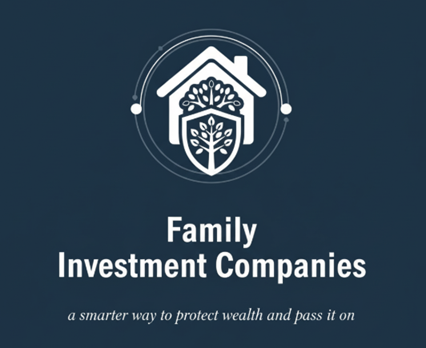-
News
-
Blog
-
Archive

Thinking about how to grow family assets, reduce “leakage” to tax, and pass wealth to the next generation without losing control? A Family Investment Company (FIC) can be a flexible, company-based wrapper for investing and succession planning. FICs are, how they're set up, how they're taxed, and when they make sense.
If you'd like advice tailored to your situation, our Taxation team works with families across the Northwest. We're experienced accountants in Bolton and happy to map the options with you.
FICs:
A Family Investment Company is a private limited company created to hold and manage family wealth. Parents typically act as directors (day-to-day control), while children or family trusts hold growth shares so future increases in value accrue outside the parents' estates. Unlike a discretionary trust, a FIC uses company law tools shares, articles, and board decisions to steer control and distributions.
Why families use FICs
- Separate control (directors) from economic benefit (shareholders).
- Use different share classes to channel income/growth efficiently.
- Potentially lower tax on retained investment income and gains vs holding personally.
- A governance framework (board minutes, policies) that professionalises family wealth.
Where the money comes from (funding options)
Common ways to capitalise a FIC:
- Director/parent loans
Parents lend funds to the company. The loan can be repaid tax-free later from company cash, giving flexibility.
- Share subscriptions
Family members subscribe for different classes (e.g., voting “A” shares for parents; non-voting growth “B” shares for children).
- Asset transfers
Existing portfolios or property can be transferred in. Watch for CGT and stamp taxes on transfers; timing and reliefs matter.
Many families start with a loan + small equity. Loans provide future extraction flexibility; equity sets ownership proportions for long-term planning.
What the FIC can invest in (and what to watch)
A FIC can hold a variety of assets:
- Listed funds and equities (including global ETFs and bonds)
- Cash, gilts and money-market funds for liquidity
- Investment property (residential or commercial; model SDLT, interest relief, and ATED where relevant)
- Private investments (subject to governance and risk)
Risk controls to agree up-front
- An investment policy and rebalancing rules
- Liquidity targets for redemptions, loan repayments, and tax
- A conflicts policy (especially for private deals)
Keeping the reins while sharing the upside (control mechanics)
Parents typically retain board control and may hold a small class of voting shares with limited dividends. Children hold non-voting growth shares. The company's articles of association and a shareholders' agreement can set:
- Who can be a shareholder (and on what terms)
- Dividend policy and approval thresholds
- Transfer restrictions and leaver provisions
- Events that trigger buybacks or redemptions
Outcome: Parents guide strategy and timing; the economic growth flows where it's intended over time.
How FICs are taxed (company and shareholder level)
Inside the company
- Corporation tax on investment income and capital gains.
- Many dividends received by UK companies are exempt under the distribution exemption rules (depends on source/type).
- Interest and rental income are taxable; expenses are deductible if wholly and exclusively for the business of the company.
- Capital gains: indexation allowance is no longer available; plan disposals carefully.
When money comes out
- Dividends to family shareholders are taxed on the recipient at dividend tax rates.
- Loan repayments to the parents (where they lent in funds) are generally not taxable it's just returning capital lent.
- Share buy-backs/redemptions may be treated as capital if conditions are met useful for restructuring or generational change.
Inheritance and anti-avoidance lens
- Gifting shares to adult children is usually a Potentially Exempt Transfer (PET) for IHT (survive seven years for full relief).
- Be mindful of settlements legislation, transactions in securities, and other targeted anti-avoidance rules structure with advice and keep robust commercial documentation.
Is a FIC the right succession tool? (decision points)
A FIC tends to make sense where you want to:
- Retain control while pushing growth to the next generation
- Build a long-term, reinvesting portfolio inside a corporate wrapper
- Introduce board discipline and clear rules for family ownership
- Manage tax across multiple family members in a transparent, governed way
It may be less suitable when:
- Your wealth is mainly owner-managed trading shares qualifying for Business Relief (a different planning route may be better), or
- The estate is relatively modest, and the cost/complexity outweighs benefits.
A quick example (illustrative only)
Parents lend £1m to a new FIC and subscribe for voting shares; two adult children subscribe £1 each for non-voting growth shares. The FIC invests in a diversified fund portfolio and a small commercial property. Over time, profits repay the parent loan (tax-free to parents), while dividends from the FIC are paid to children within their allowances and bands as appropriate. Parents keep board control and can pace distributions in line with family plans.
Governance checklist (to keep your FIC tidy)
- Bespoke articles and a shareholders' agreement
- Board calendar (quarterly meetings, minutes, investment report)
- Dividend policy and liquidity plan
- Conflict of interest register
- Annual tax calendar and investment cost tracking
Final thoughts: will a FIC work for your family?
A Family Investment Company can separate control from benefit, allow tax-aware reinvestment, and create a professional governance frame for family wealth. The best outcomes come from careful design of shares and articles, clear investment policy, and regular board discipline. If you're weighing trusts vs companies or want to explore a hybrid approach, get numbers, documents, and succession goals on the table first.
Start a confidential scoping conversation with our team via Taxation and we'll outline structures, tax implications, timelines, and ongoing governance that fit your family's goals.